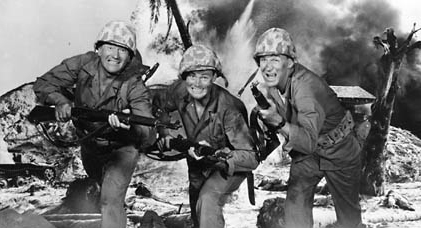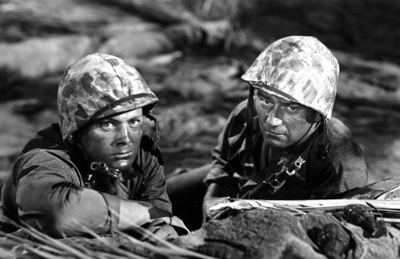
 |
|
|
|
In the 1950s and early 1960s, those of us little kids whose parents didn't talk much about the war years learned what it was all about -- or a cockeyed version of what it was all about -- from TV and the movies. Shows like Victory at Sea drilled us with the info that it was real serious stuff, that an entire generation had made a major sacrifice. Movies dramatizing war combat were all around us, but the one that seemed the most urgent is this action epic from Republic Pictures. Maybe it made a big impact because it was ubiquitous on the tube; I must have seen parts of it ten times (especially the ending) before watching the whole thing. And of course it starred the Greatest American That Ever Lived in the form of John Wayne. At age eight Wayne was our definition of the American hero. If he wasn't killing the enemy on beaches, he was doing it in airplanes. He could be friendly and sincere look, but he also had the meanest stare we'd ever seen. 1949's Sands of Iwo Jima gives us John Wayne at the top of his form. Before he started parodying himself, before every one of his film posters showed him hitting somebody, Wayne had made himself into a sharp actor/personality in full charge of his image. He's much better than the script for Iwo Jima, bringing authority and humor to a character written as both a hard-ass and a softie, depending on what scene is up. With Red River behind him, Wayne no longer had to apologize for his acting, not even to John Ford. Wayne had already produced a picture or two and was angling to get Republic to do his 'Alamo' project. He most likely directed himself in Iwo Jima, which was probably not a problem for the veteran director Allan Dwan. 2 
Sands of Iwo Jima is one of the first postwar movies to take a no-buts, no doubts patriotic look back at the conflict. When victory was announced there were three or so years in which war-themed pictures were out of fashion; people had simply had enough of the subject. Then they bounced back, but at first not as rah-rah pictures. Home of the Brave addressed racism in the armed forces (which weren't integrated until 1948). Films noir about returning soldiers weren't in the habit of waving the flag. Dore Schary's superior Battleground was a humanistic look at the hardships faced by troops, not negative in its outlook but also not classifiable as a 'let's all enlist' bandwagon movie. Made just before the Korean conflict, Sands of Iwo Jima is first and foremost a paean to the Marine Corps. It set the pattern for the 1950s, when most war movies were so service-oriented that their content could have been directed by whichever branch of the military was being honored. The uncomplicated story takes us from a U.S.M.C. training camp to the beach landings at Tarawa and Iwo Jima. Tough Sgt. Stryker (Wayne) gets the young leathernecks under his command in shape for combat. Some strong personalities are involved. Stryker once held higher ranks but has been busted, presumably for drinking and fighting; he's separated from his wife and sometimes talks with a bitter streak. Young private Peter Conway (John Agar) is the son of an old friend of Stryker, but hates both him and his old man for being hardheaded militarists. Peter's wife is expecting a baby, and he wants to break with family tradition and raise his son as a civilian. Insolent Private Al Thomas (Forrest Tucker) dislikes Stryker for busting him for insubordination; so Stryker has two Marines giving him a hard time and talking behind his back. The rest of the crew is a great bunch of guys. Cpl. Dunne (Arthur Franz) and Capt. Joyce (John McGuire) are experienced and steadfast. The Flynn brothers (Richard Jaeckel & Bill Murphy) are just big kids, always fighting. In only his fourth movie, 17 year-old Martin Milner flashes a cherubic smile and carries reading material into combat. 'Handsome' Dan Shipley (Richard Webb) is a cheerful pretty boy. And the joker in the pack is the wisecracking Regazzi (Wally Cassell). 
If the (Oscar-nominated) story of brave men in combat seems rather simplified, it needs to be remembered that not enough time had passed for comprehensive reappraisals of the experience fighting the Japanese. Author James Jones' first book From Here to Eternity wasn't published until two years later. The comparatively tame 'social comment' in the 1949 musical South Pacific was at the time considered controversial, touchy stuff. Sands of Iwo Jima could have been written from the Marines' book of rules. Sergeants work the men 'til they drop. Some of the jarheads think Stryker's he's a sadist, although he alternates his snarling with behavior more in line with a puppy dog. To make a point in training, he hits a soldier hard in the face with the butt of his rifle, hard enough to send him to the infirmary. 3 The Marine Corps seems to be a place where everybody can be themselves, including Stryker. His troops don't always call him 'sir'. He narrowly avoids a court-martial after starting a fight with one of his own men. Yet the Corps heals all wounds. The same recruits that complain about Stryker also shield him from the Shore Patrol when he's drunk. By the end of the movie both of the Marines that cursed his name come to revere the Sarge as a great guy. Lovely Adele Mara meets genteel John Agar at a dance, and marries him just before he ships out. Favorite Julie Bishop (Jacqueline Wells from the great The Black Cat) is a bar girl who picks up Stryker and takes him back to her Honolulu apartment. Stryker takes one look at her baby girl, finds out she's got a man of her own and plays the perfect gentleman, improving his own morale at the same time. The message is clear: don't worry ladies, if your husbands become Marines you can be sure that they'll always behave like boy scouts. 
Sands of Iwo Jima has excellent battle scenes. The new footage is of course a bad mismatch with the several-film-generations-removed actual combat footage used, yet the Oscar-nominated editing fits them together well. Nobody in 1949 would have dreamed of degrading the new footage to match the old (What? Pay money to make my film look bad?) but had they done so viewers might well have believed that all the actors had been filmed in a real battle. The fighting is still WW2-style stock stuff, where actors lower on the playbill get knocked off first, while the 'special supporting dying' is saved for name talent. The casualties are frequent and for a time seem fairly arbitrary, which is a big positive in realism - when a Marine we 'know' is shot, his buddies haven't time to do much more than make a concerned face. Even more realistically, after the first battle the combatants aren't completely sure who survived and who didn't. Nothing's that organized and there are other priorities, like surviving. We see Japanese soldiers only once or twice. Unlike movies made during the war, no effort is made to smear them as stereotypes or fanatics. But not until the Korean War got underway would movies acknowledge that Japanese-Americans had fought in Europe (Go for Broke!). The timing seems politically motivated -- in movie terms, the defeated Germans were accepted as new allies as soon as trouble started with the Soviet Union. Audiences were impressed with the savagery of fighting in the South Pacific, where unusually brutal methods were necessary to kill enemy soldiers that wouldn't surrender. Iwo Jima shows the Marines using flame throwers, but not battle footage of men burned alive. During the war, recreations of such actions were treated as an opportunity for cheers and laughter. Right after the surrender shock effects of that kind were no longer deemed desirable. The only time things feel wrong is when Stryker gets his men into position with his usual yelling, after being told by his Captain to be as quiet as possible. That, and a concluding scene in which 'the guys' sit casually yakking away, in a spot where one of their buddies was shot just seconds before. The film ends with a recreation of the famous flag-raising scene on Iwo Jima. The main credits say that the actual soldiers that raised the flag, including the noted Ira Hayes, did the honors on film. Another credit acknowledges the Marine who raised the actual first flag on the island. 
John Wayne would be voted most popular male star the next year, dethroning Bing Crosby. Everyone is good in the movie, following Wayne's assured lead. Even John Agar shows some ability. This is also the banner year for modest actor Wally Cassell -- he's a great sidekick in this show, and does similar duty for James Cagney as gang member Cotton Valetti in White Heat. The film was shot in Southern California, which makes for the most arid-looking South Pacific imaginable. But Republic (with a ton of free help from the Marines) stages two very convincing large-scale beach landings, which were the Saving Private Ryan of their day. Sands of Iwo Jima solidified the public impression of John Wayne as America's greatest fighting man. 
Olive Films is back and going strong with this classy new Blu-ray of Sands of Iwo Jima. One would think a picture this popular would have been printed to death but Republic seems to have taken good care of its library. A few shots have some negative digs and that's about it -- the show is in almost perfect shape with very beefy sound. Olive has no extras for what must be considered a flagship Republic feature attraction. That, and it's a shame no English subtitles are offered -- many of the elderly veterans itching to see this show must surely be having hearing problems by now.
On a scale of Excellent, Good, Fair, and Poor,
Sands of Iwo Jima Blu-ray rates:
Footnotes: 1. I ran into an impressive Flashbak photo and comment page, Iwo Jima: A Story Of Death, Glory And Propaganda In Wonderful Photos. It's pretty inspirational. The photo above with the coffee joke is from The War Movie Buff Page. The Author doesn't identify himself.
2. Hollywood veteran? Heck, Dwan is almost THE original Hollywood director. I think he was here shooting before anybody, even De Mille. His name is on hundreds of shorts filmed between 1911 and 1914.
3. This boot-camp 'get their attention with some brutality' message was later parodied in Starship Troopers. The joke there is that futuristic medicine is so advanced, a drill sergeant can routinely maim a recruit to properly impress his peers. The unlucky 'Mobile Infantryman' is sent to sick bay. Corpsman!

Reviews on the Savant main site have additional credits information and are often updated and annotated with footnotes, reader input and graphics.
Review Staff | About DVD Talk | Newsletter Subscribe | Join DVD Talk Forum |
| ||||||||||||||||||